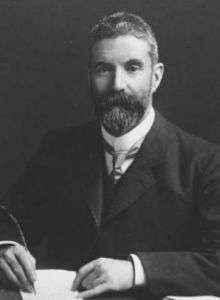Austin Chapman
| The Honourable Sir Austin Chapman KCMG | |
|---|---|
 | |
| Member of the Australian Parliament for Eden-Monaro | |
|
In office 29 March 1901 – 12 January 1926 | |
| Preceded by | New seat |
| Succeeded by | John Perkins |
| Personal details | |
| Born |
10 July 1864 Near Bowral, New South Wales |
| Died |
12 January 1926 (aged 61) Sydney |
| Nationality | Australian |
| Political party |
Protectionist (1901–09) Liberal (1909–17) Nationalist (1917–26) |
| Spouse(s) | Catherine O'Brien |
| Relations | Albert Chapman (brother) |
| Children |
James Austin Chapman John Austin Chapman |
| Occupation | Company director |
Sir Austin Chapman KCMG (10 July 1864 – 12 January 1926), Australian politician, was a member of several early federal ministries. He was born in Bong Bong near Bowral, New South Wales and educated at Marulan Public School and was apprenticed as a saddler at an early age. In about 1884 he went into business as a publican, storekeeper and auctioneer in Queanbeyan, and later became an investor and company director.[1]
Political career
In 1894 he was elected to the New South Wales Legislative Assembly as MLA for Braidwood.[2] Like most politicians from the southern border regions of New South Wales, he was an active supporter of federation of the Australian colonies.
In 1901 Chapman was elected to the first House of Representatives as MP for the Division of Eden-Monaro (his brother Albert succeeded him as the member for Braidwood in the New South Wales Parliament). A Protectionist, he was Minister for Defence in the first ministry of Alfred Deakin (1903–04), Postmaster-General in the second Deakin ministry (1905–08), and Minister for Trade and Customs from 1907–08. After a long period on the backbench as a result of a stroke in 1909, which paralysed one of his arms, he was appointed Minister for Trade and Customs and Minister for Health in the Bruce government in February 1923. He was criticised by both Nationalists and the Country Party and he resigned in May 1924 on the grounds of ill health and was subsequently made a KCMG.[1]
Chapman's most important contribution was his influence on the choice of the site of Australia's national capital, Canberra. He lobbied hard for the site on the Molonglo River near Queanbeyan, in his electorate. The success of his lobbying benefited many of his friends who owned land in the area, and also greatly boosted trade in Queanbeyan, the nearest town to the site. He was still MP for Eden-Monaro at the time of his death in Sydney of cerebro-vascular disease. He was survived by his wife, two daughters and two sons, James Austin Chapman and John Austin Chapman who both became distinguished soldiers.[1][3] The Canberra suburb of Chapman was named after him.
References
- 1 2 3 Gibbney, H. J. "Chapman, Sir Austin (1864–1926)". Australian Dictionary of Biography. Australian National University. Archived from the original on 22 March 2007. Retrieved 26 March 2007.
- ↑ "Sir Austin Chapman (1864–1956)". Members of Parliament. Parliament of New South Wales. Archived from the original on 22 October 2012. Retrieved 16 February 2010.
- ↑ Thompson, Roger C. "Chapman, John Austin (1896–1963)". Australian Dictionary of Biography. Australian National University. Archived from the original on 22 March 2007. Retrieved 26 March 2007.
| Political offices | ||
|---|---|---|
| Preceded by James Drake |
Minister for Defence 1903–1904 |
Succeeded by Anderson Dawson |
| Preceded by Sydney Smith |
Postmaster-General 1905–1907 |
Succeeded by Samuel Mauger |
| Preceded by William Lyne |
Minister for Trade and Customs 1907–1908 |
Succeeded by Frank Tudor |
| Preceded by Arthur Rodgers |
Minister for Trade and Customs 1923–1924 |
Succeeded by Littleton Groom |
| Preceded by Walter Massy-Greene |
Minister for Health 1923–1924 |
Succeeded by Herbert Pratten |
| Parliament of New South Wales | ||
| Preceded by Alexander Ryrie |
Member for Braidwood 1891–1901 |
Succeeded by Albert Chapman |
| Parliament of Australia | ||
| Preceded by New |
Member for Eden-Monaro 1901–1926 |
Succeeded by John Perkins |
